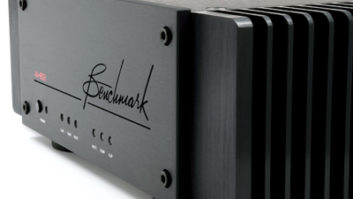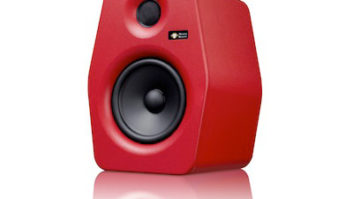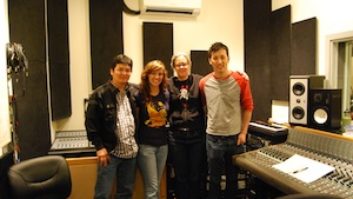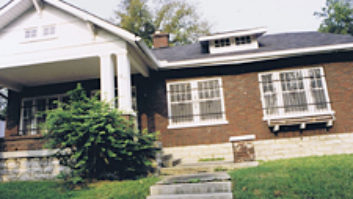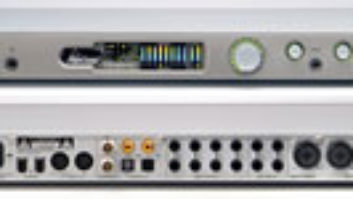When DAT recorders evolved to their technical limits, the Alesis Masterlink stepped up to the next level. Most users treat Masterlink as a storage device, because recording, basic editing, burning a reference CD and archiving are a breeze. More than a 24-bit/96kHz recorder and CD burner, Masterlink also offers onboard SHARC DSP processing, but few Masterlink users take advantage of the unit’s onboard compressor (DSP-1), multiband EQ (DSP-2) and peak limiter (DSP-3) features. Here are some hints to get the most from your Masterlink.
COMPRESSION
Because Masterlink’s compressor threshold starts at 0 dBFS (as in full-scale), the only place to go is down. The gain reduction is quite literal — the reverse of what I had expected, because some compressors add gain to meet the threshold — but the Alesis approach allows for some headroom for the processing that follows, and the metering option within the DSP-1 menu structure in Version 2.11 is helpful. Another reason to upgrade to the latest software.
EQUALIZATION
The lack of an interface makes Masterlink’s EQ rather challenging. You have to paint with broad strokes because microsurgery is just too tedious. With three bands — plus “Q” — for each band, there are plenty of options. Patient people will either be rewarded or carried off to the loony bin.
LIMITER
Like the compressor, limiter threshold starts at 0 dBFS. From there, it behaves in a completely opposite manner — gain is increased as threshold decreases. Attack is fixed (fast), while release has an extremely wide range, from 25 microseconds to 9.9 seconds.
NORMALIZATION
Of all Masterlink DSP functions, normalization (DSP-4) is the least understood. Last in the chain, the Normalizing tool can be considered a “level scanner” that reports the headroom margin. The resulting report can be engaged or not, or anything in between. Part of the mastering process is to make all of the pieces fit — this does not always mean maximizing the level. Rather than continuing the habit of “slamming zeroes,” 24-bit technology allows our ears a little relief. You can commit and dither later.
In a traditional workstation, a track is scanned for its peaks — the distance between them — “digital zero” is determined, and, if desired, the level of the entire track can be raised by that amount and, typically, a new file is rendered. Masterlink can also scan the track for peaks, entering the amount into a window, so users can tweak or toggle on/off in real time. Masterlink normalization is a DSP process, and there’s no need to render a new file. However, because DSP-4 is at the end of the chain, it becomes a moving target, subject to the amount of other processing that is done. For example, calculating the headroom above the peaks — with all processes off — might yield 4 dB of headroom. Add some compression, EQ and limiting, and the amount of normalization will change. Because normalization is virtual and therefore “real time,” it can be switched in and out. You’ll know right away if re-calculation is necessary.
DRIVE SPACE: THE FINAL FRONTIER
The most desirable Masterlink upgrade is replacing the internal 4.3GB hard drive with something larger. To be safe, cable length should not exceed IDE’s 18-inch standard. Other users have recommended a 20GB, 5,400 rpm EIDE drive. I tried a 40GB Western Digital drive without success, but a Maxtor 40GB drive worked fine when one of its jumpers was set to “4092 cylinder limit.” The original 4.3GB drive held 5.3 hours of 44.1kHz/16-bit material. The 40GB drive bumped that to 51 hours! The manual doesn’t breach this topic, but at least you can download the latest operating system plus an Adobe PDF version of the installation procedure at www.alesis.com. Also, info on other hard disk options can be found on my www.tangible-technology.com site.
On the removable side of things, www.TigerDirect.com sells pull-out drive caddies for about $15 and the ROMTEC “Trios,” a 3-drive selector box that’s $49 after rebate. Trios is designed for computer users who want separate operating systems on individual drives. It worked flawlessly with Masterlink.
I’d like to thank Bennet Spielvogel, A.T. Michael MacDonald and Greg Prestopino for their contributions to this article. Visit www.tangible-technology.com for more about this Masterlink project.
Alesis Electronics, 1633 26th Street, Santa Monica, CA 90404; 310/255-3400; fax 310/255-3401; www.alesis.com.
